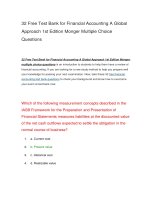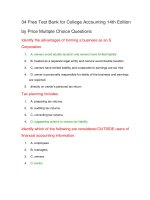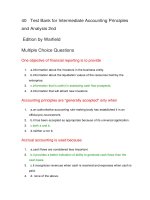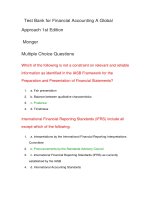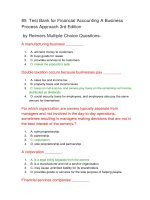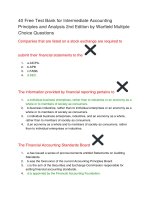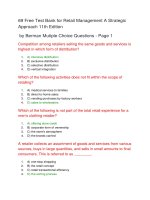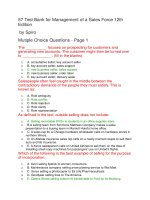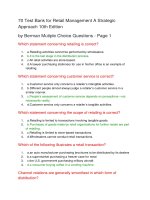Test bank for college accounting a contemporary approach 2nd edition
Bạn đang xem bản rút gọn của tài liệu. Xem và tải ngay bản đầy đủ của tài liệu tại đây (81.51 KB, 15 trang )
Test Bank for College Accounting A Contemporary
Approach 2nd Edition
True False Questions - Free Text Questions -
Multiple Choice Questions
The form of a business organization that is not affected by the
withdrawal or death of an owner and can continue forever
is
1.
A.the sole proprietorship.
2.
B.the partnership.
3.
C.the corporation.
4.
D.the nonprofit organization.
The financial affairs of a business and the financial affairs of the
owners should be
1.
A.combined in the firm's accounting records.
2.
B.reported in different parts of the firm's accounting records.
3.
C.combined only if the owner wants them to be.
4.
D.kept totally separate.
Which of the following is NOT part of the process of accounting
for financial information?
1.
A.Recording
2.
B.Identifying
3.
C.Communicating
4.
D.Classifying
Owners and managers need financial information in order to
1.
A.grant loans.
2.
B.issue credit.
3.
C.collect taxes.
4.
D.make decisions.
The Sarbanes-Oxley Act includes rules on
1.
A.auditor retention.
2.
B.auditor reliability.
3.
C.auditor rotation.
4.
D.auditor reporting.
The FASB develops Statements of Financial Accounting
Standards in the following order
1.
A.issues an exposure draft, obtains responses to the exposure draft, issues a
statement of principle, issues a discussion memorandum, obtains responses to the
discussion memorandum
2.
B.issues a discussion memorandum, obtains responses to the discussion
memorandum, issues an exposure draft, obtains responses to the exposure draft, issues
a statement of principle
3.
C.issues a discussion memorandum, obtains responses to the discussion
memorandum, issues a statement of principle, issues an exposure draft, obtains
responses to the exposure draft
4.
D.issues a statement of principle, issues a discussion memorandum, obtains
responses to the discussion memorandum, issues an exposure draft, obtains responses
to the exposure draft
The corporations whose stock can be bought and sold on stock
exchanges and in over-the counter markets are referred to
as
1.
A.privately owned corporations.
2.
B.closely held corporations.
3.
C.publicly owned corporations.
4.
D.sole proprietorships.
Managerial accounting is
1.
A.public accounting.
2.
B.government accounting.
3.
C.private accounting.
4.
D.tax accounting.
Management advisory services are designed to help
1.
A.government agencies.
2.
B.clients.
3.
C.employers.
4.
D.creditors.
A firm issues periodic reports called
1.
A.financial statements.
2.
B.summaries.
3.
C.tax returns.
4.
D.audits.
Which of the following is NOT a service of public accounting
firms?
1.
A.Auditing
2.
B.Tax accounting
3.
C.Management advisory services
4.
D.Investment services
Which of the following is NOT a type of information
communicated by the financial statements?
1.
A.Whether or not the business is profitable
2.
B.What types of assets business owns
3.
C.How long the business has been in operation
4.
D.How much the business owes others
The government agency that has final authority over the
financial reporting of publicly owned corporations is
1.
A.the Securities and Exchange Commission.
2.
B.the Federal Trade Commission.
3.
C.the Internal Revenue Service.
4.
D.the Financial Accounting Standards Board.
The review of financial statements to assess their fairness and
adherence to GAAP is
1.
A.accounting.
2.
B.preparation.
3.
C.compliance.
4.
D.auditing.
Which of the following is NOT an area in which accountants
usually practice?
1.
A.Public Accounting
2.
B.Industrial Accounting
3.
C.Governmental Accounting
4.
D.Managerial (Private) Accounting
An independent accountant who provides accounting services
to the public for a fee is a
1.
A.CIA.
2.
B.CFE.
3.
C.CMA.
4.
D.CPA.
An act passed in response to the wave of corporate accounting
scandals is the
1.
A.Saxon-Ordanly Act.
2.
B.Sarbanes-Oxley Act.
3.
C.Sardonic-Oxone Act.
4.
D.Sorbine-Oxide Act.
A form of the partnerships business entity is
1.
A.LLP.
2.
B.LLC.
3.
C.INC.
4.
D.DBA.
Tax accounting involves tax compliance and
1.
A.tax evaluation.
2.
B.tax planning.
3.
C.tax configuration.
4.
D.tax obfuscation.
The group of accounting educators who offer their opinions
about proposed FASB statements, after research has
been done to determine the possible effects on financial
reporting and the economy, is
1.
A.the FCC.
2.
B.the AICPA.
3.
C.the SEC.
4.
D.the AAA.
Tax planning includes
1.
A.preparing tax returns.
2.
B.auditing tax returns.
3.
C.correcting tax returns.
4.
D.suggesting actions to reduce tax liability.
Which of the following is NOT a type of information
communicated by the financial statements?
1.
A.The equity, or value, of the business
2.
B.The amount spent on costs (expenses) of the business
3.
C.The types of products and services the business provides
4.
D.The amount of revenue earned by the business
The area of accounting that involves the preparation of internal
reports for a firm's executives and the analysis of the data
in these reports to aid in decision making is known as
1.
A.financial accounting.
2.
B.managerial accounting.
3.
C.auditing.
4.
D.cost accounting.
The following are all government agencies except
1.
A.SEC.
2.
B.AICPA.
3.
C.IRS.
4.
D.FBI.
An example of an economic entity is
1.
A.a town.
2.
B.a business.
3.
C.a nonprofit hospital.
4.
D.a church.
Owners are not personally responsible for the debts of the
business if the form of business organization is
1.
A.the sole proprietorship.
2.
B.the partnership.
3.
C.the corporation.
4.
D.the nonprofit organization.
The Financial Accounting Standards Board is responsible for
1.
A.auditing financial statements.
2.
B.developing generally accepted accounting principles.
3.
C.establishing accounting systems for businesses.
4.
D.making recommendations to the Securities and Exchange Commission.
All financial statements submitted to the SEC by publicly owned
corporations must include an auditor's report prepared
by
1.
A.an internal auditor.
2.
B.the firm's managerial accountant.
3.
C.an independent certified public accountant.
4.
D.anyone in the accounting department.
True False Questions
Tax planning is any activity associated with the preparation of
tax returns and the audit of those returns.
1.
True
2.
False
As the first step in the development of generally accepted
accounting principles, the FASB writes an exposure draft,
which explains the topic under consideration.
1.
True
2.
False
In a sole proprietorship, the owner is responsible for the debts
of the business if the firm is unable to pay.
1.
True
2.
False
Public accountants work on the staff of federal, state, or local
governmental units.
1.
True
2.
False
Accounting is defined as the process by which financial
information about a business is recorded, classified,
summarized, interpreted, and communicated to owners,
managers, and other interested parties.
1.
True
2.
False
The death or withdrawal of onepartner ends the partnership.
1.
True
2.
False
Most owners and managers rely heavily on the accountant's
judgment and knowledge when making financial
decisions.
1.
True
2.
False
When a business is organized as a sole proprietorship, the
owner may combine his/her personal financial information
with the business financial information.
1.
True
2.
False
The purpose of accounting is to provide financial information
about an economic or social entity.
1.
True
2.
False
Currently, generally accepted accounting principles are
developed by the American Institute of Certified Public
Accountants (AICPA)
1.
True
2.
False
The owners and managers of a business are the only users of
the Financial Information.
1.
True
2.
False
Accountants provide financial information to various parties so
they can make business decisions.
1.
True
2.
False
An accounting system is designed to accumulate and classify
data about a firm's financial affairs and summarize it in
the general journal.
1.
True
2.
False
A business partnership can have only two partners.
1.
True
2.
False
The Securities and Exchange Commission (SEC) requires that
publicly owned corporations submit financial statements
to it each year.
1.
True
2.
False
Anyone can invest in a closely held corporation.
1.
True
2.
False
Public accounting firms provide three major types of services:
auditing,tax accounting, and management advisory
services.
1.
True
2.
False
Laws passed by Congress in 1933 and 1934 gave the Securities
and Exchange Commission (SEC) final say on matters of
financial reporting by publicly owned corporations.
1.
True
2.
False
The SEC uses financial information to determine a company's
tax base.
1.
True
2.
False
The separate entity assumption applies only to the corporate
form of business.
1.
True
2.
False
The financial statements and the auditor's report must be made
available to stockholders of publicly owned corporations.
1.
True
2.
False
Free Text Questions
Generally accepted accounting ____________________ are
financial accounting standards that are changed and
refined in response to changes in the environment in
which
Answer Given
businesses operate. principles
The owners of a corporation are called ____________________.
Answer Given
stockholders; shareholders
Accountants normally choose to practice in one of three areas:
public accounting, managerial accounting, or
____________________ accounting.
Answer Given
governmental
What is the "language of business?" List three groups who use
this financial information.
Answer Given
Accounting is the language of business. The groups who use this information are
owners and managers, suppliers, banks, tax authorities, regulatory agencies and
investors, customers, and employees and unions.
The people, companies, or government agencies to whom a firm
owes money are called ____________________.
Answer Given
creditors
The Securities and Exchange Commission (SEC) regulates the
accounting methods and financial reporting of
____________________ owned corporations
Answer Given
publicly
List three individuals or groups who use financial information to
make decisions about a firm. For each listed, give an
example of why they would need the information.
Answer Given
Owners and managers-to evaluate results of operations or to make decisions about
the future. Suppliers-to assess the ability of the firm to pay its bills and to set credit
limits. Banks-to determine whether the firm can repay the loan in a timely manner. Tax
authorities-to determine the tax base of the firm. Regulatory agencies and investors-to
fulfill the requirements of the law. Customers-to determine whether service on
purchases will continue into the future. Employees and unions-to negotiate wages and
benefits.
Accounting is often referred to as the language of
____________________.
Answer Given
business
A partnership has ____________________ or more owners
Answer Given
two
List at least five activities performed by managerial
accountants.
Answer Given
Establishing accounting policies, managing the accounting system, preparing financial
statements, interpreting financial information, providing financial advice to
management, preparing tax forms, performing tax planning services, and preparing
internal reports for
Explain the process the Financial Accounting Standards Board
(FASB) employs to develop and issue Statements of
Financial Accounting Standards.
Answer Given
The FASB writes a discussion memorandum explaining the topic under consideration.
Then it holds public hearings so interested parties can express their opinions orally or
in writing. After these hearings, the FASB releases an exposure draft describing the
proposed statement. FASB then receives and evaluates public comment about the
draft, and finally FASB members vote on the statement, which, if approved by four of
the seven members, is then issued.
Discuss the differences among: entity, economic entity, and
social entity.
Answer Given
Entity-recognized as having its own separate identity. Social entity-nonprofit
organizations. Economic entity-business or organization whose major purpose is to
produce a profit.
The financial statements submitted to the SEC by a corporation
must be ____________________ by an independent
accountant to ensure their fairness and adherence to
generally accepted accounting principles.
Answer Given
audited
The results of the accounting process are summarized in
periodic reports called financial ____________________.
Answer Given
statements
Nonprofit organizations, such as cities, public schools, and
public hospitals, are referred to as
____________________ entities.
Answer Given
social
A form of business entity owned by one person is called a(n)
____________________.
Answer Given
sole proprietorship
The three major legal forms of business entity are the sole
proprietorship, the partnership, and the
____________________
Answer Given
corporation
You have just entered college and decide to pursue a career as
an accountant. What are the three areas in which an
accountant can practice?
Answer Given
Public accounting, managerial (private) accounting, and governmental accounting
Tax accounting is a service offered by public accounting firms
that involves tax ____________________ and tax
planning.
Answer Given
compliance
List the "Big Four" public accounting firms in the United States.
Answer Given
Deloitte & Touche, Ernst & Young,KPMG, and PricewaterhouseCoopers
List at least three of the provisions of the Sarbanes-Oxley Act.
Answer Given
The act: tightens regulation of financial reporting by publicly held companies and their
accountants and auditors; creates a five-member Public Company Accounting
Oversight Board to oversee the accounting profession which in turn is overseen by the
SEC; includes rules on consulting services, auditor rotation, criminal penalties,
corporate governance, and securities regulation; requires auditors to maintain all audit
or review work papers for five years; requires chief executives and chief financial
officers of publicly traded corporations to certify their financial statements; requires
quicker disclosure of material changes in a firm's financial position; provides protection
for whistle blowers; and lengthens the time investors have to file lawsuits for securities
fraud.
Audited financial statements include an auditor's report. What
does this auditor's report contain?
Answer Given
It contains the auditor's opinion regarding the fairness of the firm's financial statements
and confirms the adherence to GAAPin those financial reports.
The process by which financial information about a business is
recorded, classified, summarized, interpreted, and
communicated to owners, managers, and other interested
parties is called ____________________.
Answer Given
accounting
Ownership in a corporation is evidenced by shares of
____________________
Answer Given
stock
What determines the independence of Certified Public
Accountants (CPAs)?
Answer Given
They are not employees of the companies they audit and they do not have a financial
interest in those companies.
There are three general services public accountants offer. List
and briefly describe each.
Answer Given
Auditing: the review of financial statements to assess their fairness and adherence to
GAAP. Tax accounting: tax compliance-dealing with the preparation of tax returns and
the audit of those returns, and tax planning-giving advice to clients on how to structure
their financial affairs in order to reduce their tax liability. Management advisory
services: helping clients improve their information systems or their business
performance.
How do sole proprietorships, partnerships, and corporations
differ?
Answer Given
Sole proprietorships-business entities owned by one person who is responsible for the
business debts and taxes. The business ends when the owner dies. Partnershipsbusiness entities owned by two or more individuals who are individually, and as a
group, responsible for the partnership's debts and taxes. A partnership ends when one
or more partners withdraw or die. Corporations-business entities with one or more
owners which can continue indefinitely unless bankruptcy occurs or the stockholders
vote to liquidate. Stockholders (owners) are not personally responsible for the
corporation's debts and can only lose the amount they invested.
